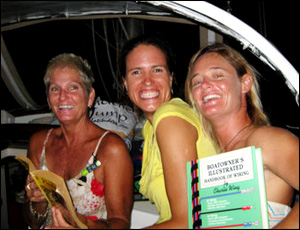As we begin a new series on Women and Cruising discussing fear and how we deal with it, we asked Lin Pardey for her thoughts. As she is overwhelmed with repairs following the flooding in New Zealand as well as preparing for her March USA seminars, she is sharing a relevant chapter from her book “Capable Cruiser“. In this chapter, Lin asked 11 pairs of willing volunteers to share their thoughts on predeparture worries, the gear that worked, failures that occurred, and thoughts they wanted to share with those waiting to set sail. We are publishing this chapter in two parts. Part 2 will appear next week.
Arriving in Apia, Samoa
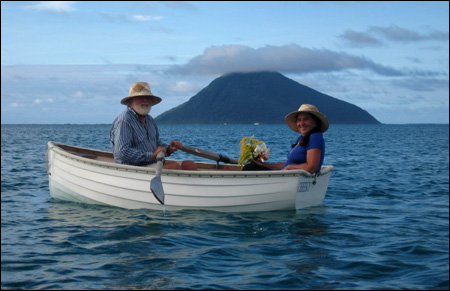 |
It felt wonderful, no concerns about a wind shift turning our anchorage into a lee shore, no rattle of anchor chain across coral heads, the boat lying still enough to use long-stemmed glasses instead of tumblers for our wine.
Even better, arriving in Apia, Samoa, meant we had woven our way past the hurricane belt between Hawaii and Mexico, through the doldrums and south of the equator. Now we’d completed the longest passages of our voyage from Ventura, California, through the Line Islands and back to our home base in New Zealand.
As Larry and I savored this latest landfall in our 42 years and 185,000 miles of wandering together, I mentioned my sense of relief at arriving here. “If you feel so good about it,” Larry commented, “can you imagine how pleased some of these first-time voyagers must feel?”
I already had some idea. In only a few hours alongside in the first marina we’d seen in several months, I’d met half a dozen of these newest voyagers and enjoyed their excitement at having made the break from life ashore and safely crossing a major ocean.
 |
| The idea for this story came after a fun dinner with seven cruising couples in Apia, Samoa. |
“They all tell me about the things that worried them before they set sail.” I said to him.
“But they went anyway didn’t they?” Larry countered. “These folks are the crème de la crème, the ones who got organized enough to break free and then actually cut the ties and kept going beyond the first landfall. It has been a long time since we were in a place where there was a whole group of new voyagers fresh from their first long passages, their first time away from easy access to marina facilities.
Why don’t you ask some of them what they worried about that never actually happened? Might give you some interesting ideas to share.”
With his urging, I made a short list of questions, and 11 pairs of willing volunteers shared their thoughts on predeparture worries, the gear that worked, failures that occurred, and thoughts they wanted to share with those waiting to set sail.
Predeparture worries
Heavy weather
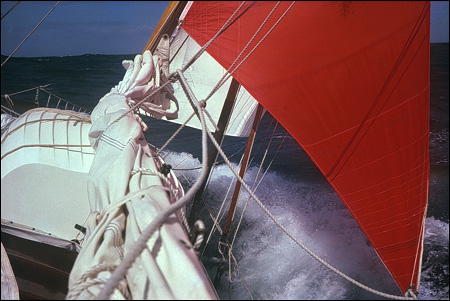 |
| Close reaching in about 45 knots of wind |
• “Really bad weather,” stated Linda and Steve Maggart, echoing a worry that was at or near the top of the list for almost everyone we questioned.
 |
| Among the first timers we interviewed were Linda and Steve Maggart on their Rhodes 40. Their biggest fear had been storm force winds. |
Linda and Steve had spent about 30 separate nights at sea before they set off from Cabo San Lucas, Baja California, in March 2008.
This was to be their very first offshore passage on their vintage sloop Linda, a 40-foot Rhodes Bounty II. With five charters in the Caribbean, plus coastal cruises from Seattle through the Inside Passage to Juneau, Alaska, and south to Cabo San Lucas, their experience level was above average among the group of first-time voyagers we met at Apia.
They, like the majority of sailors along the Pacific routes this season, had encountered stronger-than-average winds, especially near the very active South Pacific Convergence Zone. The system seemed to linger for weeks between Bora Bora and Tonga, stretching as far north as the Penrhyn Atoll in the Northern Cooks, where we also sailed through its 35- and 40-knot gusts. This, plus the reinforced trade winds caused by a La Niña year, had not been what folks expected along the “milk run.”
But Linda and Steve both gave their boat full credit for handling these conditions comfortably and they felt they had done a good job of making sure they had ways of securing everything on board for such conditions.
• John Boggs on Don Pedro, a 47-foot Beneteau sloop, had sailed from Victoria, Canada, through the Panama Canal in a smaller yacht 28 years earlier. This was to be his wife Linda’s first offshore voyage on the boat they had owned for six years.
In spite of his previous experience, he too worried most about extremely bad weather. When we asked, “What do you wish you had more of now that you are out here?” John answered, “More bad-weather experience.” This must be one of the hardest things for new cruisers to acquire. Very few potential voyagers are willing to—or have the time or opportunity to—head out into a gale just to see how it feels. They rarely get a chance to try reefing their sails and moving about on deck and below to learn how their gear really works when the sea gets snarly.
• Two boats owned by interviewees had suffered full knockdowns while running between Bora Bora and Suwarrow Atoll. One suffered serious mast damage, the other had damaged lifeline stanchions. Neither had excessive water get inside the boat and no one was injured, and once each of these crews was able to repair the damages and continue onward, they, like all of the other interviewees, felt they had been pretty well prepared for the heavier winds they encountered.
Interestingly, both of the men on the boats that suffered knockdowns expressed their concern that they had let down their female partners. One said candidly, “When the boat came upright and I saw the damage, then I looked at the fear on her face and felt so terrible. This is definitely not what I promised her cruising would be like.” Women, please take note: No matter how much we may feel we are equal partners in any sailing situation, men will always feel they are personally and ultimately to blame if something major goes wrong on board.
• Two people mentioned that they wished they had spent a few days at sea not only in strong winds but also in moderate running or reaching winds. Had they experienced the constant motion of being at sea, each would have made changes to the cockpit and accommodations to create more comfortable seating and lounging positions.
One commented: “My ass was sore after a few days of running. The inch-thick cockpit seat cushions were too darned hard. I couldn’t find a decent place to wedge myself in and read in the cockpit or down below.”
Being becalmed
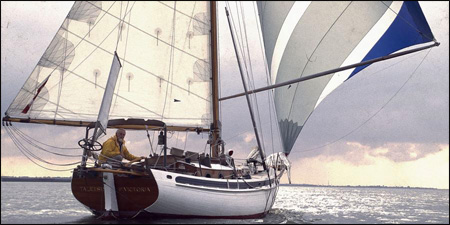 |
| Interestingly, none of the sailors we interviewed had been concerned about light winds before they set off. But when we met several of these sailors after they’d voyaged further, they wanted to know more about the light wind sails we carry. |
Interestingly, Liz Strash and Mike Scott on Argonaut, a well-maintained Cal 40, worried almost as much about being becalmed as they did about encountering heavy weather.
“The crewman who sailed with us really freaked out when we actually did get becalmed a week out of Cabo. He started counting our food supplies, figuring out how long we could survive out there if the wind never came back. We tried to reassure him, but he was like a caged tiger for a day and a half—until the winds filled in. After that, he never felt as excited about the voyage.” (Larry and I wondered whether he had just read Coleridge’s Rime of the Ancient Mariner.)
Liz and Mike continued on their own after reaching the Marquesas Islands.
Gear failures
 |
• They were delighted with their voyaging, eager for more, and able to laugh at all the concerns they’d had about breaking things. “We worried that the mast might come down, that the sails would get ripped up.”
But by the time they reached Apia, their gear failures turned out to be, according to Mike, “nothing we really couldn’t do without. Our head stopped working while we could still see Mexico, the refrigeration quit three days later. The watermaker seals leaked and had to be replaced and the block holding the gimbals on the stove broke.”
• John and Nancy Powers, on their 48-foot sloop Meridian, worried about “through-hull fittings letting go, major engine problems, and someone falling overboard. Knock on wood, none of these happened,” John said. “In fact,” he added, “not much went wrong. But I am glad I had the spares I needed to keep things working. I’d tell new voyagers, if you need one, get two. There are no West Marine outposts here. So get the stuff now!”
• Craig Compton, who made this voyage with his wife, Kay, on their 28-foot BCC, Little Wing, echoed Mike’s worries about “everything breaking.” In contrast, however, he feels he carried far too many spares. “I installed everything on the boat other than the engine by myself. I used new parts as I did the installation and kept the old parts as the spares. I didn’t need backup spares for the spares.”
The late Hal Roth first wrote about installing new parts and keeping the originals as a way to be sure the spare parts fit and the right tools were on board. It’s a practice we have always followed for vital equipment, such as bilge-pump diaphragms.
• Although the group of sailors we interviewed was small, their list of gear failures does parallel what we have seen since 1968. Refrigeration was mentioned the most often, engine fresh-water pump impellers came a close second, and watermaker problems were third.
John on Don Pedro mentioned that his watermaker problem was caused by using tap water to flush his system. When he contacted the manufacturer, he learned that the chlorine in city water was responsible for ruining the membrane. John suggested that we remind people to use only distilled water for flushing. (Seven of 10 interviewees had watermakers.)
|
In part 2, Lin writes about other common worries as well as suggestions for those preparing to set sail: |
About Lin and Larry Pardey
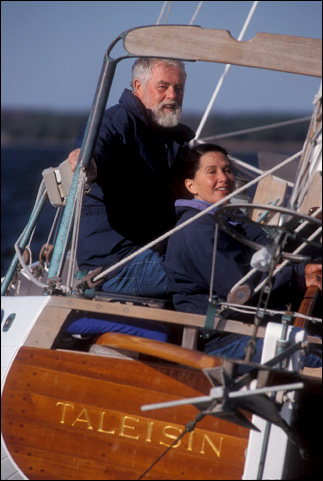 Lin and Larry have voyaged more than 200,000 miles together on self-built engine-free wooden boats. Their voyages have taken them around the world, both east-about and west-about, including counter-to-the-prevailing-wind passages south of the great southern capes.
Lin and Larry have voyaged more than 200,000 miles together on self-built engine-free wooden boats. Their voyages have taken them around the world, both east-about and west-about, including counter-to-the-prevailing-wind passages south of the great southern capes.
Their 11 books and four DVDs include narratives as well as highly useful information on voyaging, storm tactics, boatbuilding, and seamanship.
The Pardey’s have been credited with launching thousands of dreams by inspiring and empowering generations of sailors. Together and separately they have been honored with many awards for their contributions to cruising and sailing. Most recently, in 2010 the Pardey’s were awarded The Cruising Club of America’s prestigious Far Horizons Award.
Currently they have just returned from exploring the waters of New Zealands Hauraki Gulf and will be flying to the US to present seminars and introduce Lin’s newest book – Bull Canyon, A Boatbuilder, a writer and other Wildlife. Monthly newsletters and cruising tips can be found at www.landlpardey.com.
Capable Cruiser
This revised and expanded third edition of The Capable Cruiser
includes 10 completely new chapters with such advice as: sixteen ways to encourage your lover (partner) to share your dream; strategies for turning sudden engine failure into a minor incident; choosing safety equipment; repairing rigging at sea. All of the original chapters have been updated to ensure that the information will be helpful for everyone who dreams of cruising—whether now or soon.The Capable Cruiser is a logical extension of the Pardeys’ Self Sufficient Sailor
, with more emphasis on seamanship underway, including careful analysis of extreme anchoring situations and solutions for mitigating them. Underlying each and every chapter is the warmth and encouragement that spurred Herb McCormick, former editor of Cruising World magazine, to label Lin and Larry Pardey “the enablers.”
Read also on this website
- First-time voyagers — What did they worry about that never happened? (Part 2)
- Join Lin and Larry Pardey at US West coast seminars as they introduce new book
More information (external links)
- Capable Cruiser is available at Lin’s website: www.landlpardey.com and amazon.com

